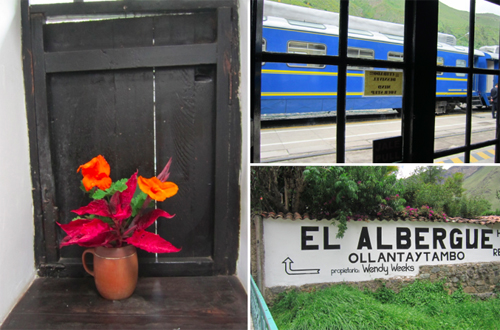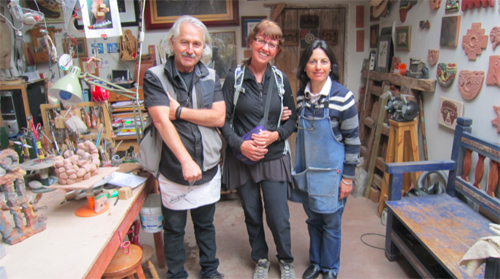Visiting the Sacred Valley is not all stones and terraces. Near the archeological sites of Pisac, Chincherro and Ollaytaytambo, are living Inca villages by the same names; designed in the same way they were in Incan times, using the same barter systems for trade, and the same system of moving water through their streets. It is a great experience to see the ruins and then see a living example of how it once was.
We stopped to visit the local market in Chincherro where women sold their wares to tourists and bartered their produce between themselves. We also watched a demonstration of how the local people use natural elements to dye the wool they weave and knit into hats and shawls and sashes for their local costumes. The young woman who gave the demonstration had a great sense of dry humour in both Spanish and English which made it very entertaining! There was the hope, of course, that at the end of the show we would buy souvenirs, and most of us did if only to support the local economy. Although they use the barter system as much as possible, there are things they need to buy in the big city and having cash is still a necessity.
We spent the night in Ollataytambo, a very charming town, on the way back from our visit to Machu Picchu. We stayed in a wonderful Hostal situated right at the train station. And I mean right beside the tracks. We simply got off the train and rang the bell at the door of our Hotel (El Alberque)! The place is owned and designed by Wendy Weeks, an artist from the US who settled in Ollaytaytambo. We also climbed to the ruins of Incan granaries we had viewed from the official archeological site and walked the original narrow Inca streets of the town. There we watched the clear water flow through the gutters on each side of the narrow streets, clean and fresh as in Inca times. No garbage or sewage to be seen. Our guide a few days before had explained that, to the Incas, water was sacred. Without clean water there would not be life. In today’s pueblos, in the homes built on the foundations of their ancestors’ dwellings, these people follow the same practices.
With the help of a local man in Urubamba we found and visited the studio of Pablo Seminario, a very interesting artist who has been creating ceramics using the methods of the Pre-Incan and Incan cultures. We were given the chance to visit with him and his wife in his workshop and discuss his process. After a short discussion about where he found his inspiration, he laughed and told us, his work could be called “Post-Inca”! One of his staff took us on a tour of the studio and we watched the crew of talented artists he employs throw and hand build pieces, apply coloured slip designs to them, and later burnish the painted pieces with smooth stones (as he believes through his research that the ancient people of this area would have done). We saw the large kilns the pieces are fired in and also admired the finished pieces in the Gallery Seminario.
The studio is also home to his extensive collection of Pre-Incan and Incan art that he studies for inspiration. His wife told us he has visions in dreams that inform his work. From talking to him, you got the sense he was a very special and spiritual man trying to keep the techniques of his ancestors alive. And of course there is the business side of things. We read that his inspired works can be found all over Peru and even on the shelves of Pier 1 Imports!
We travelled between these villages by combi (small local buses) or collectivos (shared taxis). In all cases we were treated fairly and felt very safe and at home with the rural Peruvians we had the chance to share a ride with. When we needed help, there was always someone to give us directions or even escort us to our destination. Often times we were speaking different languages, but the job got done.
Our visit to the Sacred Valley left us with a better understanding of the culture and heritage of this region. In the middle of it all we took the train to Aguas Calientes and the short bus ride to Machu Picchu where we walked through (as the heavens rained down on us), one of the most intact Inca cities in Peru. With that experience under our belt, our trip to the world of the Incas was nearly complete.
We spent the night in Ollataytambo, a very charming town, on the way back from our visit to Machu Picchu. We stayed in a wonderful Hostal situated right at the train station. And I mean right beside the tracks. We simply got off the train and rang the bell at the door of our Hotel (El Alberque)! The place is owned and designed by Wendy Weeks, an artist from the US who settled in Ollaytaytambo. We also climbed to the ruins of Incan granaries we had viewed from the official archeological site and walked the original narrow Inca streets of the town. There we watched the clear water flow through the gutters on each side of the narrow streets, clean and fresh as in Inca times. No garbage or sewage to be seen. Our guide a few days before had explained that, to the Incas, water was sacred. Without clean water there would not be life. In today’s pueblos, in the homes built on the foundations of their ancestors’ dwellings, these people follow the same practices.
With the help of a local man in Urubamba we found and visited the studio of Pablo Seminario, a very interesting artist who has been creating ceramics using the methods of the Pre-Incan and Incan cultures. We were given the chance to visit with him and his wife in his workshop and discuss his process. After a short discussion about where he found his inspiration, he laughed and told us, his work could be called “Post-Inca”! One of his staff took us on a tour of the studio and we watched the crew of talented artists he employs throw and hand build pieces, apply coloured slip designs to them, and later burnish the painted pieces with smooth stones (as he believes through his research that the ancient people of this area would have done). We saw the large kilns the pieces are fired in and also admired the finished pieces in the Gallery Seminario.
The studio is also home to his extensive collection of Pre-Incan and Incan art that he studies for inspiration. His wife told us he has visions in dreams that inform his work. From talking to him, you got the sense he was a very special and spiritual man trying to keep the techniques of his ancestors alive. And of course there is the business side of things. We read that his inspired works can be found all over Peru and even on the shelves of Pier 1 Imports!
We travelled between these villages by combi (small local buses) or collectivos (shared taxis). In all cases we were treated fairly and felt very safe and at home with the rural Peruvians we had the chance to share a ride with. When we needed help, there was always someone to give us directions or even escort us to our destination. Often times we were speaking different languages, but the job got done.
Our visit to the Sacred Valley left us with a better understanding of the culture and heritage of this region. In the middle of it all we took the train to Aguas Calientes and the short bus ride to Machu Picchu where we walked through (as the heavens rained down on us), one of the most intact Inca cities in Peru. With that experience under our belt, our trip to the world of the Incas was nearly complete.



















No comments:
Post a Comment